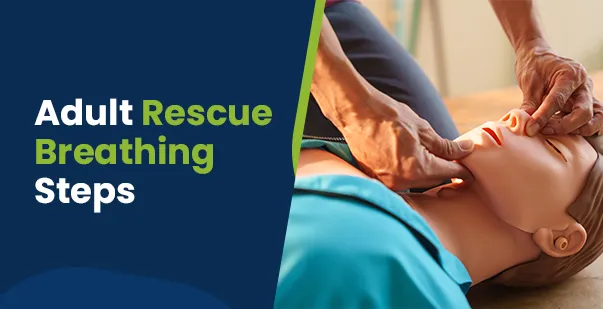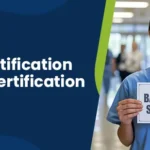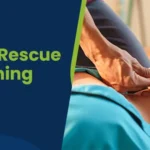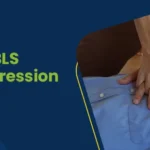Table of Contents
- Introduction
- What Is Rescue Breathing for Adults
- When Is Rescue Breathing Necessary for Adults?
- How to Perform Adult Rescue Breathing
- What to Do When You Don’t Have a Barrier Device
- Rescue Breathing vs. Compression-Only CPR
- What Are the Common Mistakes to Avoid in Rescue Breathing?
- How Does Rescue Breathing Save Lives?
- Get Certified to Learn About Rescue Breathing
When you walk down a street and find someone collapsing suddenly, what is your first course of action? Of course, to check whether the person is breathing or has a pulse. If you are an expert in providing cardiopulmonary resuscitation (CPR), you will start giving chest compressions right away. However, there are times when you have to resort to another technique, rescue breathing for adults, to save the victim’s life.
It’s a life-saving technique that helps oxygen reach the lungs when breathing stops, but the heart is still working. According to UMass Memorial Health, if the adult is not breathing but has a pulse, you must give one rescue breath every 5 to 6 seconds. This accounts for around 10 to 12 breaths per minute. So, keep reading to learn more about adult rescue breathing, its benefits, and other details below.
What Is Rescue Breathing for Adults?
Rescue breathing is often misunderstood or overlooked, but it is a crucial step in Basic Life Support (BLS). It is used when a person has a pulse but isn’t breathing, a condition known as respiratory arrest. This can happen due to opioid overdose, drowning, asthma, allergic reactions, or neurological issues.
How It Works: Oxygen is delivered manually through mouth-to-mouth or a barrier device to keep the brain and vital organs functioning. This is important to maintain oxygen flow until the person starts breathing again or emergency medical help arrives. Unlike full or hands-only CPR, which includes chest compressions, this technique is used when the heart is still beating. It focuses solely on supporting breathing, not circulation.
Read More: The Ultimate BLS Cheatsheet (+Infographics)
When Is Rescue Breathing Necessary for Adults?
BLS adult breathing techniques are a must during emergencies because they help you assess a victim’s health immediately. Please note that performing it at the right time ensures your intervention is appropriate and effective.
Checking for a Pulse and Breathing
Before performing rescue breaths, you need to check if the person has a pulse. For adults, the carotid artery in the neck is the easiest spot to check for pulse. It is situated at the side of the neck, which you have to feel for at least 5 seconds and no more than 10 seconds. Simultaneously, check breathing by looking at the chest, listening for air movement, and feeling for airflow near the nose or mouth. When to start rescue breathing:
- No breathing (or only gasping) but a pulse is present.
- If both breathing and pulse are absent, begin full CPR with chest compressions.
Common Scenarios Requiring Rescue Breaths
You can not perform CPR without compressions, as they keep the blood flowing. However, certain situations may cause respiratory arrest without cardiac arrest, where rescue breaths become especially important. These include:
- Drug overdose (especially opioids)
- Near drowning
- Choking (if airway clears after Heimlich)
- Head injury affecting the brainstem
- Severe asthma attack or anaphylaxis
- Neurological conditions (e.g., stroke, head trauma affecting the respiratory center)
- Carbon monoxide poisoning
- Seizures that lead to postictal (after-seizure) respiratory pause
In these cases, rescue breathing without chest compressions is the best approach aimed at delivering oxygen to the lungs until the person begins breathing again or emergency medical services arrive
How to Perform Adult Rescue Breathing?
You may find it easy to give mouth-to-mouth for adults BLS, but this involves knowing the proper techniques to perform it appropriately. The BLS protocol outlines exactly how to carry out rescue breathing safely. It’s mandatory that every trained individual know these steps and when to use them.
Step 1: Ensure Scene Safety and Get Help
Before intervening, ensure the environment is safe for both you and the victim. Then, call 911 or ask someone else near you to call. If available, keep an automated external defibrillator (AED) nearby in case the person loses their pulse.
Step 2: Position the Person and Open the Airway
Place the person on their back and use the head-tilt, chin-lift technique to open the airway. If you suspect a spinal injury, use the jaw-thrust technique without tilting the head.
Step 3: Deliver Rescue Breaths
Use a pocket mask or barrier device if you get hold of one anywhere nearby. Pinch the nose shut and make a seal over the mouth. Then, deliver one breath every 5 to 6 seconds. Each breath should be able to last about 1 second and cause a visible chest rise.
Step 4: Monitor and Continue
Make sure to check the victim’s pulse every 2 minutes and continue breathing support until they breathe on their own or emergency help arrives.
What to Do When You Don’t Have a Barrier Device?
Learning when to give rescue breaths is not enough. You must also know the steps to follow when you don’t have a barrier device on hand. These steps are:
- Ensure the airway is open using the head-tilt, chin-lift.
- Pinch the nostrils shut, seal your mouth over theirs
- Give a gentle breath lasting 1 second.
- If the chest doesn’t rise, reposition the head and try again.
- Continue with one breath every 5 to 6 seconds, watching for visible chest movement.
Note: Though some rescuers hesitate due to hygiene concerns, mouth-to-mouth remains an effective and accepted emergency technique, especially when no barrier device is available.
Rescue Breathing vs. Compression-Only CPR
One of the biggest questions in emergency care is: Should I perform rescue breaths or stick to compression-only CPR? The answer depends on the victim’s condition:
| Criteria | Rescue Breathing Only | Compression-Only CPR |
| When to Use | Person has a pulse but is not breathing (respiratory arrest) | Person has no pulse and is not breathing (cardiac arrest) |
| Target Scenario | Opioid overdose, near drowning, choking (after airway clears), asthma, anaphylaxis | Sudden cardiac arrest (e.g., from heart attack) |
| Training Required | Yes – knowledge of breathing techniques needed | Can be performed by laypersons without formal CPR training |
| Breathing Rate | 1 breath every 5–6 seconds (about 10–12 breaths per minute) | No breathing involved – only continuous compressions |
| Chest Compressions | Not performed unless pulse is lost | 100–120 compressions per minute, 2–2.4 inches deep |
| Duration | Continue until the person starts breathing, EMS arrives, or the pulse is lost | Continue until help arrives, an AED is available, or the person regains consciousness |
| Use of Equipment | May involve barrier device or bag-valve-mask (BVM), especially in healthcare settings | No equipment required |
| Risk of Harm | Low when performed correctly; over-ventilation can be harmful | Low risk – better to do something than nothing |
| Best for | Respiratory-related emergencies | Cardiac-related emergencies |
| Reassessment Frequency | Check pulse and breathing every 2 minutes | Continue until signs of life or professional help arrive |
What are the Common Mistakes to Avoid in Rescue Breathing?
Rescue breathing seems simple, but incorrect technique can reduce its effectiveness when dealing with someone with a heart blockage or respiratory issue. That is why you must keep the following considerations in mind when providing rescue breathing for adults:
Giving Breaths Too Fast or Too Forcefully
One of the most common mistakes is hyperventilating the patient. Too much air too quickly can force air into the stomach, causing gastric inflation and increasing the risk of vomiting and aspiration.
How to avoid it? To avoid this, deliver each rescue breath gently over one second, just enough to make the chest rise. Allow the patient to exhale before giving the next breath to prevent excess air buildup.
Poor Seal or Airway Position
If the seal isn’t tight or the airway isn’t open, the breath won’t go into the lungs.
How to avoid it? Ensure a tight seal over the victim’s mouth and use the head-tilt, chin-lift or jaw-thrust technique. If the chest does not rise, reposition and try again.
Empowering People to Act, Not Panic
While some may believe these life-saving techniques are only for healthcare professionals, this can cause hesitation in emergencies.
How to avoid it? BLS training is designed for everyone. Hence, you must encourage everyone around you, including teachers, coaches, security guards, office workers, and everyday citizens, to pursue this training.
Read More: ACLS: What Does ROSC Mean?
How Does Rescue Breathing Save Lives?
Rescue breathing has saved countless lives in emergencies where the heart is still beating but breathing has stopped. Key scenarios include:
Overdose Cases
Opioids suppress the brain’s respiratory center, and, as a result, breathing slows down or stops entirely, while the heart may still be beating.
Role of rescue breathing: It plays a key role here by providing oxygen to the brain and other organs during emergencies. This usually proves helpful before naloxone, an opioid reversal medication, takes effect. The brain can become deprived of oxygen without rescue breaths in such situations and often leads to cardiac arrest or death.
Near Drowning Events
The lack of oxygen is usually the primary cause of collapse in near-drowning incidents. Water in the lungs blocks gas exchange, and cardiac arrest can quickly follow if oxygen isn’t restored.
Role of rescue breathing: If you want to reverse oxygen deprivation (hypoxia) before the situation worsens, then early rescue breaths are the best. This is beneficial, especially if the victim is pulled from the water and has a pulse but isn’t breathing. Restoring oxygen in those first few minutes can easily stabilize the person until emergency responders arrive.
Asthma and Severe Allergic Reactions
Severe asthma attacks or anaphylaxis can block the airways and often cause inadequate oxygen intake.
Role of rescue breathing: Rescue breathing can provide oxygen until the airway is cleared or medical help arrives. This especially applies if a person becomes unresponsive and stops breathing but still has a pulse.
Choking Incidents (Post-Relief)
A choking victim may still be unconscious and not breathing even after being relieved of any obstruction.
Role of rescue breathing: Rescue breaths can help reintroduce oxygen into their system. This buys sufficient time for emergency responders and prevents long-term brain damage.
Get Certified to Learn About Rescue Breathing
Rescue breathing for adults is an excellent life-saving technique that allows you to help victims in emergencies. In the moments between respiratory arrest and cardiac arrest, your ability to perform proper rescue breaths could determine whether someone survives.
Investing a few hours in a BLS training course can prepare you and make you confident in emergencies. One breath, given at the right time, could be all it takes to save a life. If you want to learn more about these adult rescue breathing techniques, enroll in the BLS certification course now.
